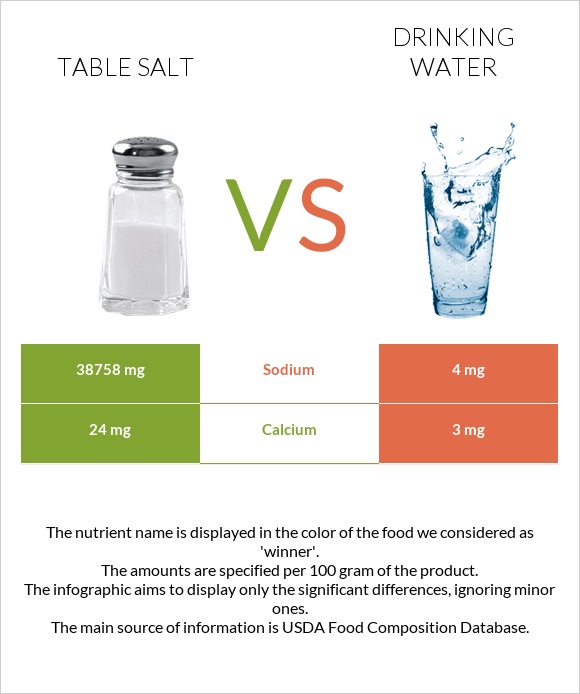Table salt vs. Drinking water — In-Depth Nutrition Comparison
Compare
How are table salt and drinking water different?
- Table salt covers your daily need for sodium, 1685% more than drinking water.
- Table salt contains 8 times more calcium than drinking water. Table salt contains 24mg of calcium, while drinking water contains 3mg.
- Drinking water is lower in sodium.
Salt, table and Beverages, water, tap, drinking types were used in this article.
Infographic

Infographic link
Mineral Comparison
Mineral comparison score is based on the number of minerals by which one or the other food is richer. The "coverage" charts below show how much of the daily needs can be covered by 300 grams of the food.
| Contains more CalciumCalcium | +700% |
| Contains more PotassiumPotassium | +∞% |
| Contains more IronIron | +∞% |
| Contains more CopperCopper | +200% |
| Contains more ZincZinc | +900% |
| Contains more ManganeseManganese | +∞% |
| Contains more SeleniumSelenium | +∞% |
| Contains less SodiumSodium | -100% |
Vitamin Comparison
Vitamin comparison score is based on the number of vitamins by which one or the other food is richer. The "coverage" charts below show how much of the daily needs can be covered by 300 grams of the food.
All nutrients comparison - raw data values
| Nutrient |  |
 |
DV% diff. |
| Sodium | 38758mg | 4mg | 1685% |
| Iron | 0.33mg | 0mg | 4% |
| Manganese | 0.1mg | 0mg | 4% |
| Calcium | 24mg | 3mg | 2% |
| Copper | 0.03mg | 0.01mg | 2% |
| Zinc | 0.1mg | 0.01mg | 1% |
| Magnesium | 1mg | 1mg | 0% |
| Potassium | 8mg | 0mg | 0% |
| Selenium | 0.1µg | 0µg | 0% |
Macronutrient Comparison
Macronutrient breakdown side-by-side comparison
Protein:
0 g
Fats:
0 g
Carbs:
0 g
Water:
0.2 g
Other:
99.8 g
Protein:
0 g
Fats:
0 g
Carbs:
0 g
Water:
99.9 g
Other:
0.1 g
| Contains more OtherOther | +99700% |
| Contains more WaterWater | +49850% |
~equal in
Protein
~0g
~equal in
Fats
~0g
~equal in
Carbs
~0g





